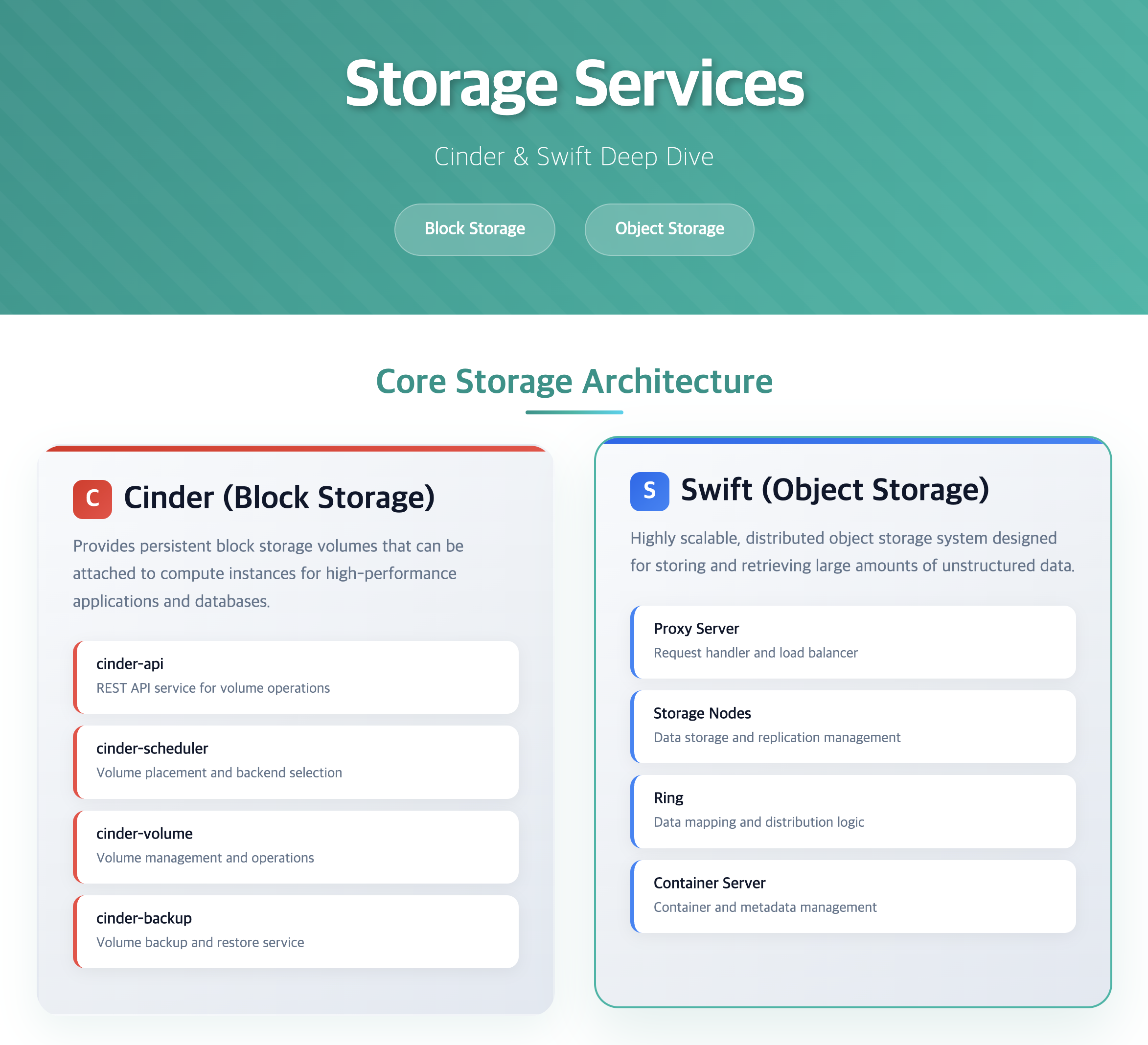6 min to read
Deep Dive into OpenStack Storage Services
Understanding OpenStack's Block Storage (Cinder) and Object Storage (Swift)

Understanding OpenStack Storage Services
OpenStack provides two distinct storage services: Cinder for block storage and Swift for object storage.
Each service is designed for specific use cases and offers different capabilities for managing data in the cloud.
Block Storage vs. Object Storage
Storage Types Comparison
OpenStack offers two primary storage solutions:
- Block Storage (Cinder): Provides virtual disk volumes for instances
- Object Storage (Swift): Offers scalable, distributed object storage
Understanding the differences between these storage types is crucial for effective cloud resource management.
Storage Architecture Overview (Diagram Description)
- OpenStack Storage
- Block Storage
- Cinder
- VM Disks
- Databases
- Object Storage
- Swift
- Media Storage
- Backups
- Block Storage
OpenStack Cinder (Block Storage)
Cinder is OpenStack’s block storage service that provides persistent storage volumes for virtual machines.
It enables users to create, manage, and attach storage volumes to instances.
Core Components
| Component | Role | Description |
|---|---|---|
| cinder-api | API Service |
|
| cinder-scheduler | Volume Placement |
|
| cinder-volume | Volume Management |
|
| cinder-backup | Backup Service |
|
Storage Backends
Cinder supports various storage backends:
- LVM: Local volume management
- Ceph: Distributed storage system
- NFS: Network file system
- iSCSI: Block-level storage protocol
- Fibre Channel: High-speed storage networking
These backends provide flexibility in storage deployment and management.
OpenStack Swift (Object Storage)
Swift is OpenStack’s object storage service that provides highly scalable, distributed storage for unstructured data.
It’s designed for storing and retrieving large amounts of data with high durability and availability.
Core Components
| Component | Role | Description |
|---|---|---|
| Proxy Server | Request Handler |
|
| Storage Nodes | Data Storage |
|
| Ring | Data Mapping |
|
| Container Server | Container Management |
|
Key Features
Swift provides several key features:
- High Availability: Data replication across nodes
- Scalability: Horizontal scaling capability
- Durability: Data integrity and consistency
- Multi-tenancy: Isolated storage for different users
- REST API: Standard HTTP interface
These features make Swift ideal for large-scale data storage.
Storage Service Comparison
Understanding the differences between Cinder and Swift is essential for choosing the right storage solution for specific use cases.
Each service has its strengths and optimal applications.
Service Comparison
| Feature | Cinder (Block Storage) | Swift (Object Storage) |
|---|---|---|
| Storage Type | Block-level storage | Object-based storage |
| Access Method | Mounted to instances | REST API access |
| Performance | High IOPS, low latency | High throughput, scalable |
| Use Cases |
|
|
Use Case Selection
Select storage based on requirements:
- Choose Cinder when: Need high-performance block storage for VMs or databases
- Choose Swift when: Need scalable object storage for large files or web content
Consider performance, scalability, and access patterns when selecting storage.
Advanced Configuration (Production Hardening)
Backend Selection Matrix (Cinder)
| Requirement | Recommended Backend | Rationale |
|---|---|---|
| High IOPS | Ceph RBD / FC | Low latency, distributed design; FC for legacy SAN performance |
| Simplicity | LVM (local) | Easy to deploy for lab/dev; not ideal for HA |
| Shared NAS | NFS | Leverage existing NAS; moderate performance, simple ops |
| Cost Efficiency | Ceph RBD | Commodity hardware, horizontal scaling, replication/EC |
Performance Tuning
- Cinder
- Use multi-attach only when strictly required; prefer single-attach for DBs
- Align volume
queue_depth,io_schedulerwith backend recommendations - Enable volume multi-pathing (DM-Multipath) for SAN/NVMe backends
- For Ceph RBD: tune
rbd_cache,rbd_stripe_count/stripe_unit, and network MTU
- Swift
- Separate proxy and storage networks; enable keepalive and pipeline tuning
- Increase object server concurrency; optimize ring with balanced weight
- Use erasure coding for colder tiers, replication for hot path
High Availability & Scalability
| Layer | Recommendation | Notes |
|---|---|---|
| Cinder API | 2+ nodes behind L7 load balancer | Stateless with shared DB/message bus |
| Cinder Scheduler | Active/active replicas | Idempotent operations, consistent DB |
| Cinder Volume | Per-backend scaling | Ensure backend HA (Ceph cluster, SAN redundancy) |
| Swift Proxy | 2+ proxies behind LB | Enable memcache cluster, tune pipeline |
| Swift Storage | 3+ zones, multiple replicas | Distribute across failure domains (rack/room/DC) |
Security & Compliance
- Enforce TLS for Cinder/Swift endpoints; restrict management networks
- Keystone RBAC: least privilege for volume/snapshot/container ops
- Enable-at-rest encryption (Cinder encryption, Swift keymaster/Barbican)
- Object lifecycle policies and container ACLs for data governance
Observability & Operations
- Metrics: Export API latency, error rate, backend queue depth, Ceph/Swift health
- Logging: Structured logs with request IDs; centralize with ELK/Loki
- Capacity: Track utilization, growth rate, hot/cold distribution
- Runbooks: Volume attach failures, stuck deletes, ring rebalance, drive replace
Troubleshooting Playbook
- Cinder Attach Fails: Check nova-compute logs, cinder-volume backend reachability, multipath status
- Slow Volume Ops: Inspect scheduler filters/weighers, backend load, DB latency
- Swift 5xx: Verify proxy memcache, ring consistency, storage node disk health
- Data Imbalance: Rebalance Swift rings, verify Ceph CRUSH rules/weights
Key Points
-
Cinder (Block Storage)
- VM disk volumes
- Database storage
- High-performance applications
- Instance-attached storage -
Swift (Object Storage)
- Scalable object storage
- Media and backup storage
- CDN content delivery
- Web-accessible storage -
Key Differences
- Access methods
- Performance characteristics
- Use case optimization
- Scalability approach


Comments